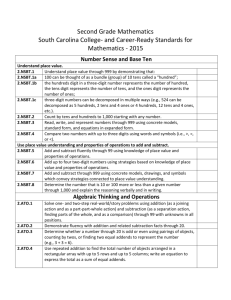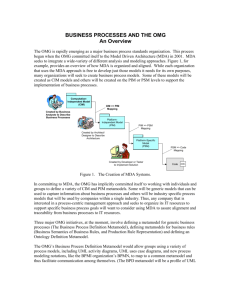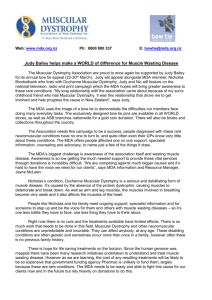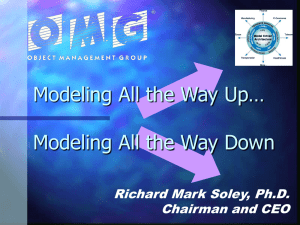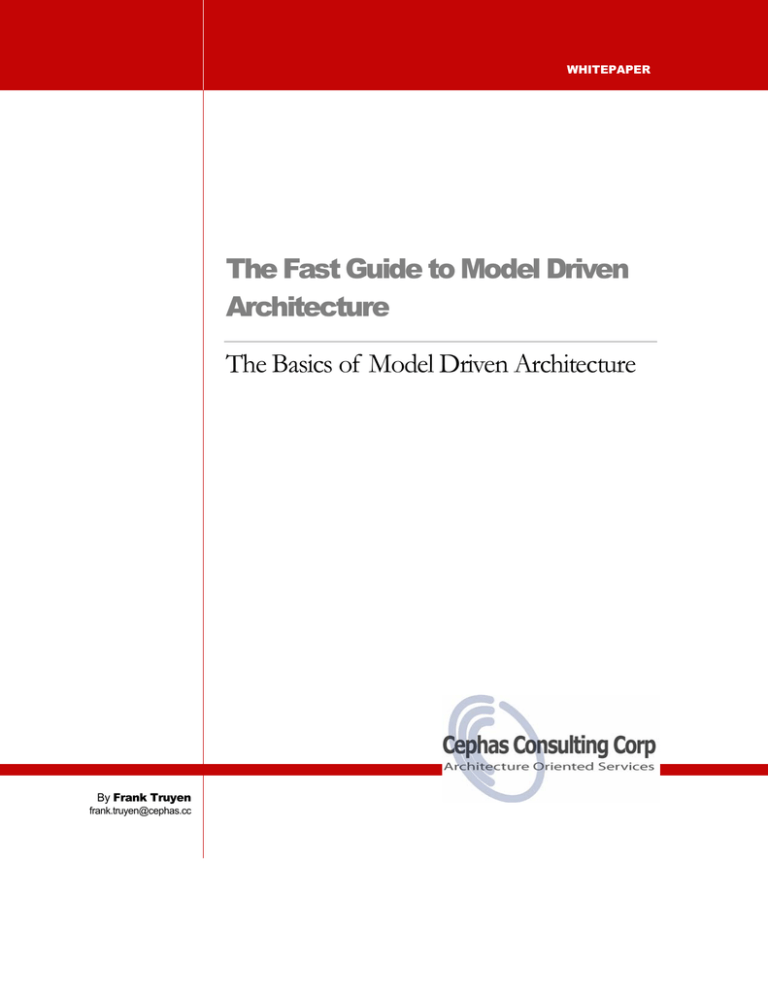
WHITEPAPER
The Fast Guide to Model Driven
Architecture
The Basics of Model Driven Architecture
By Frank Truyen
frank.truyen@cephas.cc
The Fast Guide to Model Driven Architecture, The Basics of Model Driven Architecture (MDA)
The Fast Guide to Model Driven Architecture
The Basics of Model Driven Architecture (MDA)
Cephas Consulting Corp
January 2006
TRADEMARKS
OMG™, Object Management Group™, Unified Modeling Language™, MOF™, CWM™ are
trademarks of the Object Management Group. CORBA®, UML®, MDA® and Model Driven
Architecture® are registered trademarks of the Object Management Group. All other products or
company names mentioned are used for identification purposes only, and may be trademarks of
their respective owners.
DISCLAIMERS
The material in this document is based on the current MDA Guide, omg/2003-06-01.
http://www.omg.org/cgi-bin/doc?omg/03-06-01.pdf.
Copyright ©2006, Cephas Consulting Corp. All rights reserved.
ii
The Fast Guide to Model Driven Architecture, The Basics of Model Driven Architecture (MDA)
Table of Contents
Summary
How to Use This Guide
1
1
Companion Paper 2, Features
1
Companion Paper 3, Practice
1
Model Driven Architecture
2
An Object Management Group (OMG) standard
2
A brief history
2
MDA in context
2
Major MDA concepts
3
System
3
Model
3
Model driven
3
Architecture
3
Viewpoint
4
MDA viewpoints
4
Platform
4
Platform independence
4
Platform Model
4
Model Transformation
4
Implementation
4
MDA models
5
Computation Independent Model (CIM)
5
Platform Independent Model (PIM)
5
Platform Specific Model (PSM)
5
A growing rate of adoption
5
The promise of MDA
5
The MDA Process
7
Transformation Mappings
7
Marking Models
8
Mapping Languages
8
Copyright ©2006, Cephas Consulting Corp. All rights reserved.
iii
The Fast Guide to Model Driven Architecture, The Basics of Model Driven Architecture (MDA)
Recording the transformations
8
Transformations illustrated
9
Generating code and other artifacts
9
Next Steps
10
Think Transition
10
Promote Tooling
10
Success Factors
10
References
11
About Cephas Consulting Corp.
12
Copyright ©2006, Cephas Consulting Corp. All rights reserved.
iv
The Fast Guide to Model Driven Architecture, The Basics of Model Driven Architecture (MDA)
Summary
This white paper is a first in a series of papers which provide a foundational
and practical guide for software developers required to work within a model
driven environment as prescribed by the OMG’s Model Driven Architecture®
(MDA®). It explains the MDA approach in terms of the major concepts, the
premises, and the goals which drive its adoption.
This helps the software developer as well as the IT manager navigate through
the concepts of MDA in order to understand its fundamental departure from
traditional software development. The paper helps the reader discover the
minimal set of requirements for a development environment to be “MDA” in a
practicable manner.
How to Use This Guide
This guide is intended to serve as a practical reference to the companion toolspecific MDA white papers. It provides the vocabulary and necessary concepts for
applying MDA, and selecting the right modeling tool for your organization’s
development environment.
F I R S T
I N
T H E
S E R I E S
ENTERPRISE
ARCHITECT
F R O M
S P A R X
S Y S T E M
Companion Paper 2, Features
In a separate series of tool-specific papers, Model Driven Architecture with …, the
modeling tool’s features are measured against our set of requirements, and the
tools specific MDA implementation features are analyzed –how compliant and
how pragmatic.
Companion Paper 3, Practice
A separate paper, MDA in Practice, is a tutorial that uses a running example to
illustrate the real application of MDA transformations. The tutorial is toolspecific and uses screen shots to show all the steps required to define and
apply MDA transformations.
Copyright ©2006, Cephas Consulting Corp. All rights reserved.
1
The Fast Guide to Model Driven Architecture, The Basics of Model Driven Architecture (MDA)
Model Driven Architecture
An Object Management Group (OMG) standard
The Object Management Group™ (OMG™) was formed as a standards
organization to help reduce complexity, lower costs, and hasten the
introduction of new software applications. One of the major initiatives
through which the OMG is accomplishing this goal is by the promotion of
Model Driven Architecture® (MDA®) as an architectural framework for
software development. This framework is built around a number of detailed
OMG specifications, which are widely used by the development community.
A brief history
In 2001 the OMG adopted the Model Driven Architecture as an approach for
using models in software development. Its three primary goals are portability,
interoperability and reusability through architectural separation of concerns.
MDA in context
One fundamental aspect of MDA is its ability to address the complete
development lifecycle, covering analysis and design, programming, testing,
component assembly as well as deployment and maintenance.
MDA itself is not a new OMG specification but rather an approach to software
development which is enabled by existing OMG specifications such as the
Unified Modeling Language™ (UML®), the Meta Object Facility (MOF™) and
the Common Warehouse Metamodel (CWM™). Other adopted technologies
which are of interest are the UML Profile for Enterprise Distributed Object
Computing (EDOC), including its mapping to EJB, and the CORBA®
Component Model (CCM).
With new platforms and technologies constantly emerging, MDA enables the
rapid development of new specifications that leverage them, and streamlines
the process of their integration. In this way MDA provides a comprehensive,
structured solution for application interoperability and portability into the
future. Precise modeling of the solution domain in UML provides the added
advantage of capturing its inherent intellectual property in a technology
neutral way.
As illustrated in the following diagram, the OMG envisions MDA to
encompass a full range of "pervasive" services, which are commonly found in
modern distributed applications.
Copyright ©2006, Cephas Consulting Corp. All rights reserved.
2
The Fast Guide to Model Driven Architecture, The Basics of Model Driven Architecture (MDA)
Major MDA concepts
System
The context of MDA is the software system, either preexisting or under
construction.
Model
A model is a formal specification of the function, structure and behavior of a
system within a given context, and from a specific point of view (or reference
point). A model is often represented by a combination of drawings and text,
typically using a formal notation such as UML, augmented where appropriate
with natural language expressions.
A specification is said to be formal when it is based on a language that has a
well defined semantic meaning associated with each of its constructs, to
distinguish it from a simple diagram showing boxes and lines. It is this
formalism, which allows the model to be expressed in a format such as XML,
in accordance with a well-defined schema (XMI).
Model driven
Describes an approach to software development whereby models are used as
the primary source for documenting, analyzing, designing, constructing,
deploying and maintaining a system.
Architecture
The architecture of a system is a specification of the parts and connectors of the
system and the rules for the interactions of the parts using the connectors 1 .
1
Shaw and Garlan, Software Architecture, Prentice Hall
Copyright ©2006, Cephas Consulting Corp. All rights reserved.
3
The Fast Guide to Model Driven Architecture, The Basics of Model Driven Architecture (MDA)
Within the context of MDA these parts, connectors and rules are expressed via
a set of interrelated models.
Viewpoint
A viewpoint is an abstraction technique for focusing on a particular set of
concerns within a system while suppressing all irrelevant detail. A viewpoint
can be represented via one or more models.
MDA viewpoints
MDA specifies three default viewpoints on a system: computation
independent, platform independent and a platform specific.
The computation independent viewpoint focuses on the context and
requirements of the system without consideration for its structure or
processing.
The platform independent viewpoint focuses on the operational capabilities of
a system outside the context of a specific platform (or set of platforms) by
showing only those parts of a complete specification that can be abstracted out
of that platform.
A platform specific viewpoint augments a platform independent viewpoint
with details relating to the use of a specific platform.
Platform
A platform is a set of subsystems and technologies that provide a coherent set
of functionality through interfaces and usage patterns. Clients of a platform
make use of it without concern for its implementation details. Examples of
platforms include operating systems, programming languages, databases, user
interfaces, middleware solutions etc.
Platform independence
Platform independence is a quality that a model may exhibit when it is
expressed independently of the features of another platform. Independence is a
relative indicator in terms of measuring the degree of abstraction, which
separates one platform from another (i.e. where one platform is either more or
less abstract compared to the other).
Platform Model
A platform model describes a set of technical concepts representing its
constituent elements and the services it provides. It also specifies constraints
on the use of these elements and services by other parts of the system.
Model Transformation
Model transformation is the process of converting one model to another
within the same system. The transformation combines the platform
independent model with additional information to produce a platform
specific model.
Implementation
An implementation is a specification that provides all the information
required to construct a system and to put it into operation. It must provide all
of the information needed to create an object, and to allow the object to
participate in providing an appropriate set of services as part of the system.
Copyright ©2006, Cephas Consulting Corp. All rights reserved.
4
The Fast Guide to Model Driven Architecture, The Basics of Model Driven Architecture (MDA)
MDA models
MDA specifies three default models of a system corresponding to the three
MDA viewpoints defined above. These models can perhaps more accurately be
described as layers of abstraction, since within each of these three layers a set
of models can be constructed, each one corresponding to a more focused
viewpoint of the system (user interface, information, engineering, architecture,
etc.).
Computation Independent Model (CIM)
A CIM is also often referred to as a business or domain model because it uses a
vocabulary that is familiar to the subject matter experts (SMEs). It presents
exactly what the system is expected to do, but hides all information technology
related specifications to remain independent of how that system will be (or
currently is) implemented.
The CIM plays an important role in bridging the gap which typically exists
between these domain experts and the information technologists responsible
for implementing the system.
In an MDA specification the CIM requirements should be traceable to the PIM
and PSM constructs that implement them (and vice-versa).
Platform Independent Model (PIM)
A PIM exhibits a sufficient degree of independence so as to enable its mapping
to one or more platforms. This is commonly achieved by defining a set of
services in a way that abstracts out technical details. Other models then specify
a realization of these services in a platform specific manner.
Platform Specific Model (PSM)
A PSM combines the specifications in the PIM with the details required to
stipulate how a system uses a particular type of platform. If the PSM does not
include all of the details necessary to produce an implementation of that
platform it is considered abstract (meaning that it relies on other explicit or
implicit models which do contain the necessary details).
A growing rate of adoption
MDA has been profitably implemented in many small and large organizations.
While some companies prefer to keep their success a secret to their
competition, many have agreed to publish their accomplishments, as can be
seen on the OMG website 2 as well as in various magazine articles 3 .
The promise of MDA
The promise of Model Driven Architecture is to facilitate the creation of
machine-readable models with a goal of long-term flexibility in terms of:
•
2
3
Technology obsolescence: new implementation infrastructure can be
more easily integrated and supported by existing designs.
http://www.omg.org/mda/products_success.htm
For example at http://www.softwaremag.com/L.cfm?Doc=2005-07/2005-07mdauml
Copyright ©2006, Cephas Consulting Corp. All rights reserved.
5
The Fast Guide to Model Driven Architecture, The Basics of Model Driven Architecture (MDA)
•
Portability: existing functionality can be more rapidly migrated into new
environments and platforms as dictated by the business needs.
•
Productivity and time-to-market: by automating many tedious
development tasks architects and developers are freed up to focus their
attention on the core logic of the system.
•
Quality: the formal separation of concerns implied by this approach plus
the consistency and reliability of the artifacts produced all contribute to
the enhanced quality of the overall system.
•
Integration: the production of integration bridges with legacy and/or
external systems is greatly facilitated.
•
Maintenance: the availability of the design in a machine-readable form
gives analysts, developers and testers direct access to the specification of
the system, simplifying their maintenance chores.
•
Testing and simulation: models can be directly validated against
requirements as well as tested against various infrastructures. They can also
be used to simulate the behavior of the system under design.
•
Return on investment: businesses are able to extract greater value out of
their investments in tools.
Copyright ©2006, Cephas Consulting Corp. All rights reserved.
6
The Fast Guide to Model Driven Architecture, The Basics of Model Driven Architecture (MDA)
The MDA Process
Whatever the ultimate target platform may be, the first step when constructing
an MDA-based application is to create a platform-independent model
expressed via UML. This general model can then be transformed into one or
more specific platforms such as CCM, EJB, .NET, SOAP, etc.
A complex system may consist of many interrelated models organized along
well defined layers of abstraction, with mappings defined from one set of
models into another. Within this global set of models horizontal
transformations may occur inside a single layer of abstraction, in addition to
the typical vertical transformations across layers.
Applying a consistent architectural style across viewpoints of the system is one
illustration of such a horizontal transformation. Other examples include:
•
Within a CIM, create a target model containing all of the business
rules defined in the core business model.
•
Within a PIM, create a target model containing only the data
elements define in the conceptual model.
•
Within a PSM, create a target JUnit test model from a Java class
model.
Note also that a PSM at one layer of abstraction may take on the role of a PIM
with regards to a further transformation down into another layer.
Beyond the perhaps simplistic notion of CIM/PIM/PSM, the two key concepts
of MDA are models and transformations.
The general pattern is:
Source
Model
Transformation
Rules
Target
Model
This pattern can be repeatedly applied to successive models, each one playing
the role of either a PIM or a PSM.
Transformation Mappings
An MDA mapping provides specifications for how to transform a PIM into a
particular PSM. The target platform model determines the nature of the
mapping. While part of the transformation can result from a manual exercise,
the intent is clearly to automate as much of the process as allowed by the
toolset in use.
Let’s take the example of a mapping which defines annotations (called marks
in MDA parlance) that are to be used for guiding the transformation of a UML
PIM to an EJB PSM: marking a UML class with the Stereotype "Session" would
result in the creation of a session bean - and other supporting classes - within
the PSM.
Transformation rules between models can be expressed:
Copyright ©2006, Cephas Consulting Corp. All rights reserved.
7
The Fast Guide to Model Driven Architecture, The Basics of Model Driven Architecture (MDA)
•
At the type level, from types specified in the PIM language to types
expressed using the PSM language. In UML, examples of such types
referred to here include class, attribute and operation.
•
In accordance to patterns of type usages in the PIM (e.g. a GOF strategy
pattern within a PIM can translate into an idiomatic equivalent in the
PSM).
•
At the metamodel (MOF) level, for transformations that need to
bridge model languages.
For the purpose of this white paper we limit our scope of discussion to
mappings from one UML model to another UML model.
Marking Models
Type mappings are generally insufficient to specify a complete transformation:
additional rules are required to specify that certain types in the PIM must be
annotated (marked) a specific way in order to produce the desired output in
the PSM. This extra information cannot be determined from the PIM itself.
A mark represents a concept in the PSM which is applied to an element of the
PIM in order to indicate how that element is to be transformed.
Marks, being platform specific, are considered part of the PSM (in a multiple
PSM scenario each PSM would use different marks against the same PIM). A
PIM plus all of the platform marks constitutes the input to the transformation
process resulting in a PSM.
Implicit or explicit transformation rules exist to indicate which model
elements in the PIM are suitable for certain marks in order to generate the
desired element in the PSM.
The set of marks can be viewed as an overlay (or transparency) placed over the
PIM for the purpose of the transformation. This set can optionally be supplied
as part of a UML profile.
Another option is to associate a set of marks with a template containing the
rules according to which instances in a model are to be transformed. These
rules can specify which values in the source model can be used to fill the
parameters of the template.
Mapping Languages
A model transformation mapping must be specified using some language, be it
a natural language, an action language, or a dedicated mapping language. The
OMG is currently in the process of adopting the MOF
Query/View/Transformation (QVT) specification as a portable mapping
language.
Recording the transformations
A record of the transformation should include a chart indicating which PIM
elements were mapped to which PSM elements and include the mapping
rule/s used for each part of the transformation.
Copyright ©2006, Cephas Consulting Corp. All rights reserved.
8
The Fast Guide to Model Driven Architecture, The Basics of Model Driven Architecture (MDA)
Transformations illustrated
The following diagram uses UML notation to present the various concepts
involved in an MDA transformation for a given platform (i.e. target model). It
distinguishes between the abstract view of the platform’s transformation
directives, and a concrete implementation in the context of a specific source
model to be transformed into this platform.
A further way to organize transformation
mappings is via an inheritance hierarchy. For
example, a mapping to create an RDBMS
information model could be specialized for
specific database vendors.
cd MDA Model
RDBMS Mapping
Oracle Mapping
SQLServ er
Mapping
Generating code and other artifacts
The final step in a transformation process is to generate the implementation
code as well as perhaps other kinds of supporting artifacts such configuration
files, component descriptor files, deployment files, build scripts, etc. The more
fully the application semantics and run-time behavior can be included in the
PSM, the more complete the generated artifacts can be.
Depending on the maturity and quality of the MDA toolset, code generation
varies from significant to substantial or, in some cases, even complete. Note
that even minimal automation simplifies the development work and
represents a significant gain because of the use of a consistent architecture for
managing the platform-independent and platform-specific aspects of
applications.
Copyright ©2006, Cephas Consulting Corp. All rights reserved.
9
The Fast Guide to Model Driven Architecture, The Basics of Model Driven Architecture (MDA)
Next Steps
Think Transition
Moving from a traditional software development approach to one that is
model driven is a full-fledged transition program that requires formal
planning, orchestration and sponsorship. Transitioning an organization to the
model driven approach is a major project/program that will take time and
resources to plan and manage over a period of years. Defining the transition
lifecycle consists of developing a strategy and a plan for each stage and
monitoring the resulting activities. This requires a major on-going effort, and
continuing support from IT management.
The transition is not a one-time process improvement effort, rather, it is a
transition program that must be formally planned, approved and funded by
management. It must be executed with all the diligence and check marks of a
real project. Moving too fast, out-of-sequence, or proceeding without proper
planning simply puts the whole transition process at risk. The main ingredient
for ensured success is keeping the end-vision of the transition in sight.
Promote Tooling
Tooling is an essential part of the MDA environment because tool capabilities
replace human skill sets. Understanding that the tools will generate most of
your project artifacts, it is crucial to establish the right infrastructure for the
development environment, along with a dedicated team to support it, manage
it, and continually evolve it to meet the IT development requirements.
The IT organization must carefully evaluate and select the right tools with the
capabilities to meet the organization’s specific requirements. The companion
tool-specific MDA papers offer guidance and feature checklists to consider.
Success Factors
Establish the foundation
Establish the foundation, the equivalent to investing the time and forethought
in the analysis phase of the transition project. The foundation is manifested as
a set of ‘blueprints’ for your transition and a measurement system to track
progress.
Set appropriate
expectations Time, effort,
Setting the appropriate expectations is crucial, especially when it comes to
keeping early expectations in bounds with the current realities of the daily
workload.
Design the development
environment tooling and
Designing the development environment properly for the model driven
approach is one of the most crucial factors for success. This is where tooling
takes over human grunt work and transformations replace routine skill sets.
Plan for pilot projects
Plan for pilot projects and don’t be tempted to jump into a real project only
equipped with notions of how to proceed in the new approach. Try before
you buy! A successful pilot can always be turned into a real deliverable.
Plan for recurrent
reviews Measure and
Plan for recurrent “review-and-adjust” milestones. This is where you put
measurement system to work. With no proof of progress, you cannot sustain
funding.
at the appropriate levels
of abstraction
and workload balance
solution delivery
from pilot to prototype
to real deliverable
adjust
Copyright ©2006, Cephas Consulting Corp. All rights reserved.
10
The Fast Guide to Model Driven Architecture, The Basics of Model Driven Architecture (MDA)
References
MDA – A Technical Perspective by the OMG Architecture Board
ftp://ftp.omg.org/pub/docs/ab/01-02-04.pdf
MDA White Paper by Richard Soley and the OMG Staff Strategy Group
http://www.omg.org/docs/omg/00-11-05.pdf
A Proposal for an MDA Foundation Model (An ORMSC White Paper)
http://www.omg.org/docs/ormsc/05-04-01.pdf
MDA Guide Version 1.0.1
http://www.omg.org/docs/omg/03-06-01.pdf
MDA Explained – The Model Driven Architecture: Practice and Promise
Anneke Kleppe, Jos Warmer and Wim Bast – Addison-Wesley
Model Driven Architecture – Applying MDA to Enterprise Computing
David S. Frankel – OMG Press
The Object Constraint Language – Getting Your Models Ready for MDA
Jos Warmer & Anneke Kleppe – Addison-Wesley
Model Driven Architecture with Executable UML
Chris Raistrick, Paul Francis, John Wright, Colin Carter, Ian Wilkie
Business Component Factory
Peter Herzum and Oliver Sims – OMG Press
Executable UML ; A Foundation for Model Driven Architecture
Marc J. Balcer & Stephen J. Mellor – Addison-Wesley
Copyright ©2006, Cephas Consulting Corp. All rights reserved.
11
The Fast Guide to Model Driven Architecture, The Basics of Model Driven Architecture (MDA)
About Cephas Consulting Corp.
C O M P A N Y
B A C K G R O U N D
Since 2001, Cephas Consulting Corp. has been active helping its corporate clients
introduce state of the art information technologies. We offer expertise in the areas of:
. Modeling business applications using object oriented techniques.
. Building distributed component infrastructures.
. Introducing formal software development processes.
. Migrating development organizations into Model Driven Architecture (MDA).
. Providing advanced UML/MDA training and mentoring.
C O M P A N Y
F O C U S
Cephas specializes in introducing UML® modeling into organizations via training and
mentoring. The team of consultants and architects at Cephas draw on many years of
experience to offer a one-stop solution addressing all aspects of managing the
enterprise meta-data.
. Training & mentoring from beginner to expert level.
. Migrating meta-data out of legacy environments.
. Training for onsite guardianship of the development environment.
. Customizing the modeling tool in order to respond to unique client requirements.
. Providing expert level support and maintenance.
C O M M I T M E N T
T O
T H E
A N D
O M G
M D A
Cephas Consulting has the required expertise to lead organizations into the use of
Model Driven Architecture. As early adopters we have successfully implemented MDA
and are pleased to be among the first participants to the MDA FastStart program put
in place by the OMG. We are also thrilled to work as OMG members on expanding the
mind share of MDA in the marketplace, because we believe it is ideally suited to deal
with the challenges of managing complex software development in times of rapid
technology obsolescence.
Our highest commitment is in achieving success through quality, and we take pride in
the accomplishments of our clients.
Website : http://www.cephas.cc
C O N T A C T
D E T A I L S
General inquiries: cephas.contact@cephas.cc
Author inquiries: frank.truyen@cephas.cc
Copyright ©2006, Cephas Consulting Corp. All rights reserved.
12


